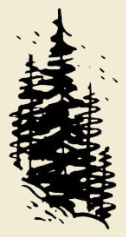By Alexandra Prince

A recent presentation by Evan Pritchard, descendant of the Micmac people and Professor of Native American history at Marist College, briefly mentioned the legend of Chief Shandaken. According to Pritchard, Shandaken is a Munsee Delaware word that likely means Land of Spruce, Land of Hemlock, or perhaps Land of Many Evergreens. It’s said that Chief Shandaken lived at the Pine Orchard near North-South Lake, the place well known today as of the site of the Catskill Mountain Hotel.
The legend goes that Chief Shandaken’s daughter Lotowana had a suitor named Norsereddin, a “proud, morose, dark-featured” non-Native man described as a descendent of Egyptian kings who lived a solitary life along the Kaaterskill Creek. Lotowana instead favored a Mohawk man and the two were married to the great chagrin of Noreseridden. During the wedding, Norseridden gave Lotowana a gift—a handsome box. It contained some kind of springed apparatus that upon being opened launched a “poisoned tooth of a snake that had been affixed to it.” The poisoned snake tooth pierced Lotowana’s hand. The venom was so strong that she died in mere minutes next to her new husband’s feet.
Norseridden tried to escape, but Chief Shandaken’s men captured him and brought him back to the cliff to be executed. Lotowana was buried while Noreseridden’s ashes “were left to be blown abroad.” Due to immense grief, Chief Shandaken decided to leave the Pine Orchard “his ancient dwelling-place, and his camp-fires never glimmered afterward on the front of Ontiora.”
There are many interesting aspects of this story to be sure. For instance, is the Pine Orchard mentioned in the story the same one we know today? And if it is, does that mean Pine Orchard is not only the site of the former Catskill Mountain House but the burial place of the legendary Lotowana? Something to consider upon your next visit to the historic site.
Note: The text quoted is from Charles M. Skinner’s 1896 Myths and Legends of our Own Land.
